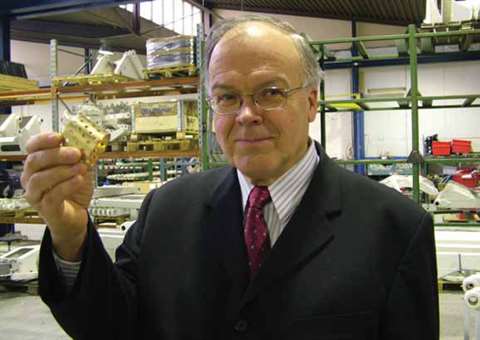In control
20 March 2008

Having more demand than you have the capacity to meet is one of the nicer problems that a manufacturer can have. It's a feeling that morethan a few access equipment supplier will haveat the moment, but there can't be many whohave seen an upturn in fortunes to the same extent asFinland's trailer mounted platform specialist, Dinolift.
At the bottom of the market in 2003, the company sold9.4 million worth of equipment. That figure had risen to€25.1 million last year, and production capacity couldwell increase another 40 to 50% this year, allowing thecompany to build in excess of 1000 units, up from 700in 2006.
Managing this growth will be almost as big a challengeas managing recession, although owner and executivechairman Lars–Petter Godenhielm, says the companydid a good job of the latter; “We were one of the onlycompanies that was clearly profitable during these[recession] years. Profit wentdown, but it was still at ‘bigbusiness’ levels.”
The company's strategy is for “controlled growth” over thenext few years, with investmentin manufacturing capabilities inFinland (see box story), as wellas expansion of sales in Europeand elsewhere.
Like many of its competitors,Dinolift is benefiting from a bigincrease in buying by Europeanrental companies. Unlike others, however, it is also ideallyplaced to increase sales into the Baltic States, Russia andother eastern European market. Ideally placed not justgeographically, but also through its sales to Finnish rentalcompanies Ramirent, Cramo and Pekkaniska, all of whomare expanding in these eastern European territories.
Russia and the Baltic States alone will account foraround a quarter of all sales this year. “[Demand] israpidly increasing [in these areas]”, says Erkki Hokkinen,Dinolift's managing director. “A few years ago it was anominal figure.”
New dealers
The company is expanding its dealership network ineastern Europe. It appointed Tapeks Noma as its Latviandealer in March and said it expected other easternEuropean and Balkan appointments in the comingmonths.
Mr Hokkinen acknowledges that the eastern Europeanmarket is still small in comparison to western Europe; “They are small, but there are plenty of countries andthere is a lot of potential.” He also points out that “EasternEurope will still grow even if the west slows down.”
The company is also benefiting from its alliance withHaulotte Group, which sells “several hundred” trailers inFrance, Spain and Portugal each year. Haulotte is alsorepresenting Dinolift in Australia, New Zealand and, fromearlier on this year, the Americas (Dino's trailers wereintroduced to the North American market on Haulotte'sstand at the ARA Rental Show in February.)
The company has yet to crack the UK, market, however. Mr Hokkinen says its premium priced machines do notmake it easy to sell to the UK, particularly given the bigpresence of Niftylift.
With the current high levels of demand, what are thepriorities for the product line? Mr Godenhielm says thecurrent trailer range from 12 to 26 m working height ispretty much where they want it to be, although he saysthey are always looking at improving the features.
One new machine will be a economical 12 m telescopicmodel, the 120T, that is to be introduced at Bauma. Itwill supercede both the 105 (the oldest in the range)and 125 models, and will be a one–person unit with analuminium, circular cage, which will keep the overallweight down to around 1.2 t, making it easy to transport. Maximum working height will be around 12 m andoutreach will be approximately 7.5 m. It will also haveground controls behind the machine, making it easy tomove on site.
Self–propelled demand
Meanwhile, the two self–propelled, outrigger machines– the 205 RXT and 240 RXT –are proving popular, particularly in eastern Europe, which is perhapssurprising given that they are more expensive than thecompany's trailers. Erkki Hokkinen says the SP modelsare popular because Russian construction sites need selfpropelledmachines and because trailer mounts “are tooeasy to steal.”
Sales of the RXT models still account for just 5%of total units, although this is because of productionconstraints; “It's because we cannot make more”, saysMr Hokkinen.
It would be natural, perhaps, for the company to enterthe small Spider market which has been so busy inEurope recently. Mr Hokkinen says it wouldn't be a bigstep for the company, “but we have no need for that atthe moment,” Similarly, the company does not have plansto enter the truck mounted sector –the cost of importingsmall trucks to Finland to then re–export them militatesagainst this, says Dinolift.
Anyway the problem isn't what new machines todevelop, it's how to build the machines that its customerswant. One problem at a time.

